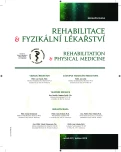The Effect of Acral Coactivation Therapy on Expiratory Muscle Strength and Lower-chest-wall Motion
Authors:
H. Měrková 1; K. Neumannová 1,2; R. Dvořák
Authors‘ workplace:
Katedra fyzioterapie, Fakulta tělesné kultury, Univerzita Palackého, Olomouc, vedoucí katedry prof. MUDr. J. Opavský, CSc.
1; Katedra přírodních věd v kinantropologii, Fakulta tělesné kultury, Univerzita Palackého, Olomouc, vedoucí katedry prof. RNDr. M. Janura, Dr.
2
Published in:
Rehabil. fyz. Lék., 22, 2015, No. 2, pp. 51-56.
Category:
Original Papers
Overview
Structural and functional breathing disorders can influence breathing pattern, decrease respiratory muscle strength and reduce chest expansion. The aim of this blind, controlled, randomized study was to determine the effect of Acral Coactivation Therapy (ACT) on respiratory muscle strength and on lower-chest-wall motion. Research group consisted of 30 healthy women with decreased expiratory muscle strength and with decreased lower-chest-wall motion at the midpoint between the xiphoid process site and the umbilicus. All participants were without any treatment for acute or chronic illness and they had no history of chronic respiratory or orthopedic disease. The participants were randomly divided into two groups. Fifteen participants underwent ACT and fifteen participants were in control group without any therapy. The results showed a statistically significant increase in lower-chest-wall motion and improvement of expiratory muscle strength in a group with therapy, while in the control group a statistically significant increase was confirmed only for expiratory muscle strength. Nevertheless, the improvement of expiratory muscle strength was lower in the control group than in the group with therapy.
We can conclude that ACT positively influences lower-chest-wall motion and expiratory muscle strength in functional respiratory disorders.
Keywords:
structural and functional breathing disorders, posture, maximal inspiratory and expiratory mouth pressures
Sources
1. BROŽOVÁ, A.: Vliv úhlového nastavení aker na aktivaci svalů horních končetin a trupu dle metodiky R. Brunkow. Diplomová práce, Karlova univerzita, Fakulta tělesné výchovy a sportu, Praha, 2006.
2. DRILLER, M., PATON, C.: The effect of respiratory muscle training in highly-trained rowers. Journal of the American Society of Exercise Physiologists, roč. 15, 2012, č. 6, s. 93-102.
3. FAROUX, B., AUBERTIN, G.: Measurement of maximal pressures and the sniff manoeuvre in children. Paediatric Respiratory Reviews, roč. 8, 2007, č. 1, s. 90-93.
4. KOLÁŘ, P., LEWIT, K.: Význam hlubokého stabilizačního systému v rámci vertebrogenních obtíží. Neurologie pro praxi, roč. 6, 2005, č. 5, s. 270-275.
5. MCCONNELL, A.: Respiratory muscle training. Edinburgh, Elsevier, 2013.
6. NEUMANNOVÁ, K.: Vliv dechové rehabilitace na rozvíjení hrudníku, ventilační parametry a vybrané kineziologické ukazatele u nemocných s asthma bronchiale a s chronickou obstrukční plicní nemocí. Dizertační práce, Univerzita Palackého, Fakulta tělesné kultury, Olomouc, 2010.
7. NEUMANNOVÁ, K.: Rozvíjení hrudníku, ventilační parametry a vybrané kineziologické ukazatele u nemocných s asthma bronchiale a chronickou obstrukční plicní nemocí. Rehabilitace a fyzikální lékařství, roč. 18, 2011, č. 3, s. 132-137.
8. NEUMANNOVÁ, K., KOLEK, V., ZATLOUKAL, J., KLIMEŠOVÁ, I.: Asthma bronchiale a chronická obstrukční plicní nemoc: možnosti komplexní léčby z pohledu fyzioterapeuta. Praha, Mladá fronta, 2012.
9. NEUMANNOVÁ, K., ZATLOUKAL, J.: Ovlivnění poruch dýchání pomocí tréninku dýchacích svalů. Rehabilitace a fyzikální lékařství, roč. 18, 2011, č. 4, s. 188-192.
10. OBAYASHI, H., URABE, Y., YAMANAKA, Y., OKUMA, R.: Effects of respiratory-muscle exercise on spinal curvature. Journal of Sport Rehabilitation, roč. 21, 2012, č. 1, s. 63–68.
11. OŠŤÁDAL, O., BURIANOVÁ, K., ZDAŘILOVÁ, E.: Léčebná rehabilitace a fyzioterapie v pneumologii. Olomouc, Univerzita Palackého v Olomouci, 2008.
12. PALAŠČÁKOVÁ-ŠPRINGROVÁ, I.: Akrální koaktivační terapie. Čelákovice, Rehaspring, 2011.
13. PAVLŮ, D.: Speciální fyzioterapeutické koncepty a programy. Praha, Cerm, 2003.
14. PRYOR, J. A., PRASAD, A. S.: Physiotherapy for respiratory and cardiac problems: Adults and peadiatrics (4. vyd.). Edinburgh, Churchill Livingstone, 2008.
15. SMOLÍKOVÁ, L., MÁČEK, M.: Respirační fyzioterapie a plicní rehabilitace. Brno, Národní centrum ošetřovatelství a nelékařských zdravotnických oborů, 2010.
16. TOUT, R., TAYARA, M., HALIMI, M.: The effects of respiratory muscle training on improvement of the internal and external thoraco-pulmonary respiratory mechanism in COPD patients. Physical and Rehabilitation Medicine, roč. 56, 2013, č. 3, s. 193-211.
17. VELÉ, F.: Kineziologie. Přehled klinické kineziologie a patokineziologie pro diagnostiku a terapii poruch pohybové soustavy. Praha, Triton, 2006.
18. ZATLOUKAL, J., MAYER, M., NEUMANNOVÁ, K., DVOŘÁK, R., LOŠŤÁKOVÁ, V.: Mechanika dýchání a její terapeutické ovlivnění u pacientů s plicní formou sarkoidózy. Rehabilitace a fyzikální lékařství, roč. 18, 2011, č. 4, s. 167-172.
Labels
Physiotherapist, university degree Rehabilitation Sports medicineArticle was published in
Rehabilitation & Physical Medicine

2015 Issue 2
- Hope Awakens with Early Diagnosis of Parkinson's Disease Based on Skin Odor
- Deep stimulation of the globus pallidus improved clinical symptoms in a patient with refractory parkinsonism and genetic mutation
Most read in this issue
- Fatigue Fracture in the Physiotherapist and Physician Practice
- The Effect of Acral Coactivation Therapy on Expiratory Muscle Strength and Lower-chest-wall Motion
- Diagnostics and Basic Principles of Dysphagia Therapy after Resection of Oropharyngeal Region Tumors
- The Use of Biofeedback in Rehabilitation in Patients with Gait Disorders after Stroke
